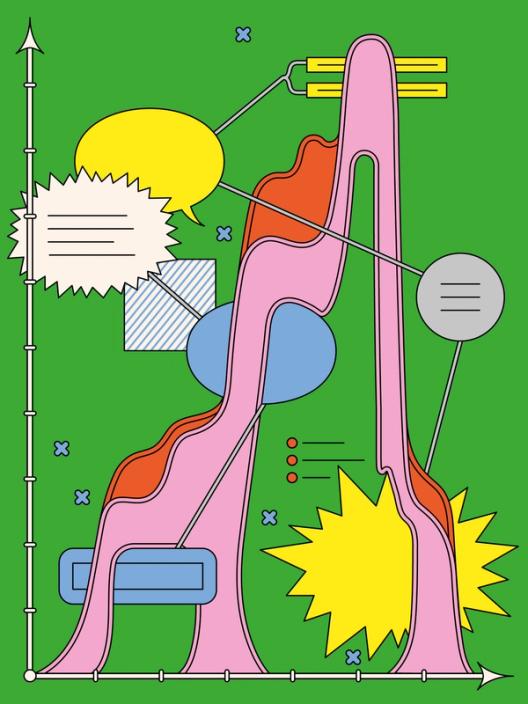The anatomy of a Super Bowl ad

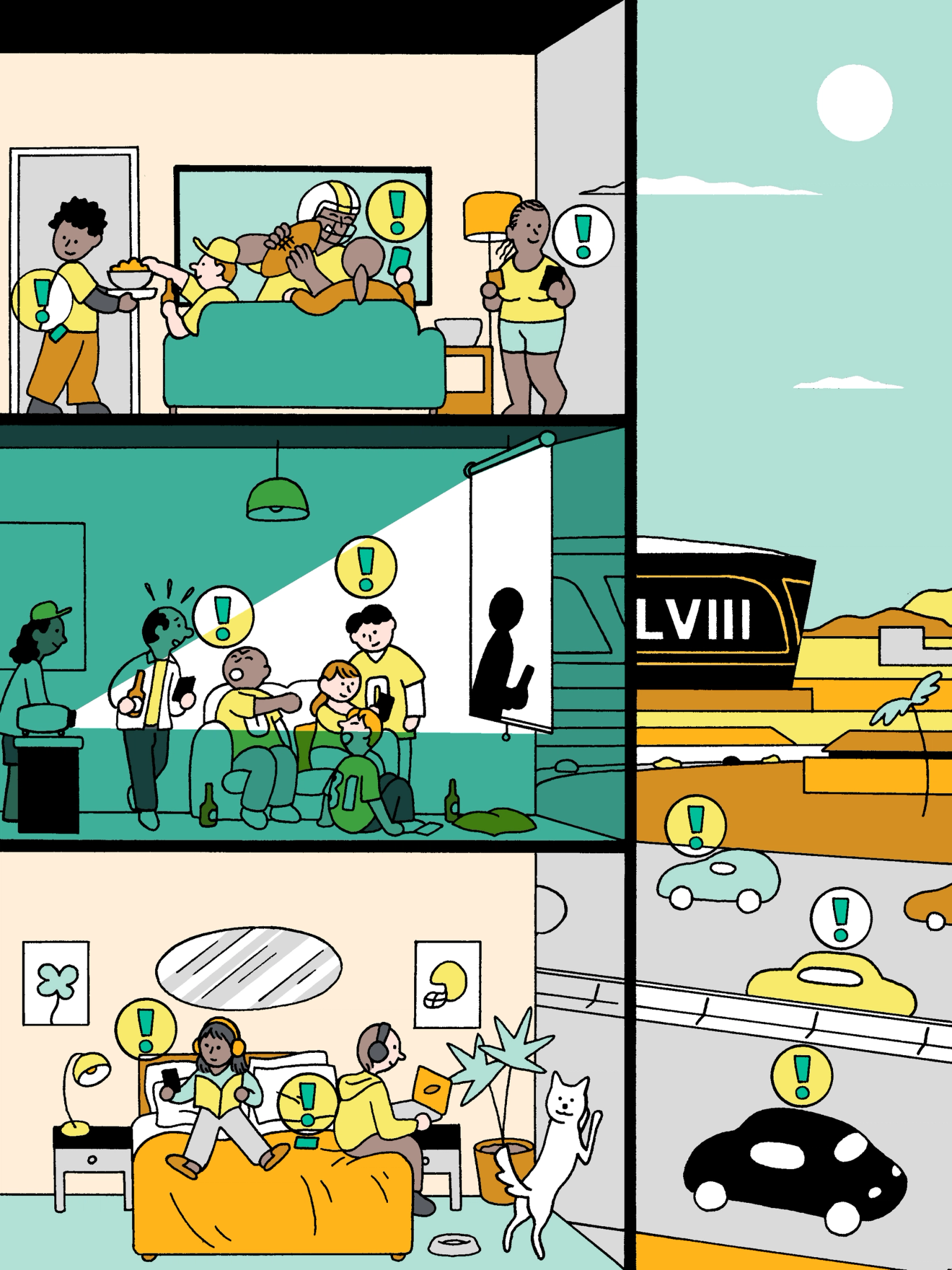
How learning app Duolingo’s cheeky five-second spot beat the odds in a crowded field.
There are two sides to Duo, the bespectacled owl mascot of the learning app Duolingo: wholesome and “unhinged,” as the internet describes him. If you caught the Super Bowl, you may have seen unhinged Duo star in his own five-second ad. In it, Duo sits in a white frame with a sheepish expression. He turns, exposing his butt, which swells like a balloon until a second Duo pops out with a flatulent notification sound and the reminder to “Do your Duolingo.” At the same time, users got a push notification from the mobile app to get back to their language lesson.
Even for a marketing team known for its risk-taking and social savvy, the concept is bold, and reflects the rapport that Duolingo has with its community. “As a social-first brand, our approach to marketing is to generate word-of-mouth and conversation,” says James Kuczynski, Global Creative Director at Duolingo. “The goal was to create a WTF moment.” The ad certainly did just that, and pulling it off meant the marketing, engineering, and Design Studio teams worked in sync for several weeks. Here’s an instant replay.
The goal was to create a WTF moment.
Building on the goal
The idea to run a Super Bowl ad was sparked by both ambition and insight. After all, it’s consistently the United States’ most-watched live event of the year, and with such a huge audience, there’s also a huge opportunity to win earned media and spark conversation. “We strive to be part of culture,” says James. “We saw the opportunity to take advantage of a moment and gain some virality.”
Additionally, data showed that big broadcast events bode well for learning: Users would do their lessons during breaks in Eurovision, and a push notification sent out during a previous Super Bowl saw the highest engagement. “We thought, ‘Okay, if we use the spot as a lesson reminder, what could that be?’” says James. The success of this earlier campaign—in which Duolingo learners got a push notification that riffed on the words Super Bowl and Superb Owl—kept coming back up during brainstorming.
In terms of the length of the ad, budget would pose a constraint. In 2023, the average price for a 30-second commercial during the Super Bowl was a whopping $7 million, so the team took inspiration from examples like Reddit’s ad in 2021 to go after a five-second spot that would trend on social media and earn tens of millions of social impressions.
Leading a cross-functional brainstorm
What can you do in five seconds? Turns out—a lot. The marketing team kicked off the first of three cross-functional brainstorms in September, after the commercial time slot had been secured. The session started with a walkthrough of a brief that outlined the opportunity, presented the goal, and gave the overarching prompt: “How do we hack and own the Super Bowl conversation in 5 seconds?” The larger team then formed four breakout groups that jumped into a FigJam file, where they brainstormed concepts that they wrote on sticky notes while a FigJam tune played. They focused on ideas that would:
- Elicit a strong reaction and generate buzz on social media
- Highlight the brand and be a tonal fit
- Extend beyond the campaign through additional content
- Communicate Duolingo’s capabilities
Then, each group nominated their top five ideas to be pitted against each other in a second round, after which everyone voted using stickers in FigJam.
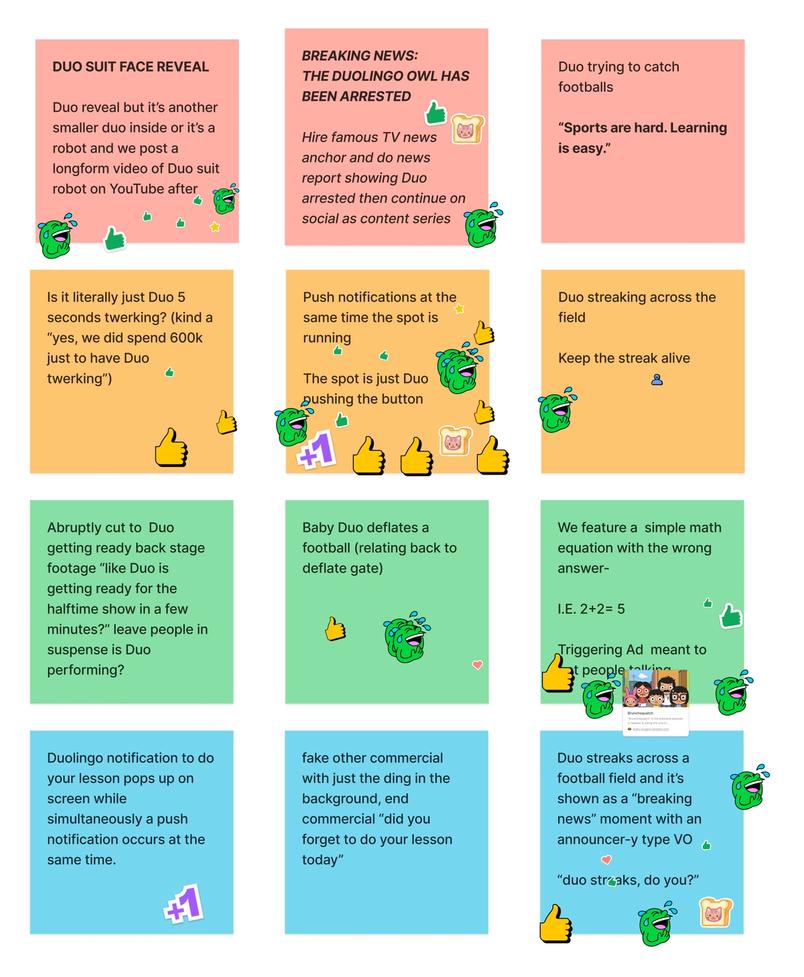

Get your team’s creative juices flowing with this brainstorming template for FigJam.
Betting on a big idea
It would take more than one brainstorming session to align on a concept, however. When the marketing, engineering, and brand studio teams reconvened, they dropped into another FigJam. This time, they would leave ideas on stickies according to different approaches:
- Hacking the five-second TV format, i.e. causing the viewer to hit pause
- Creating a meme moment, i.e. an image of Duo that viewers will share
- Tapping into Duolingo lore, i.e. Buff Duo
- “Just cuz…the internet will share”
Learn how the Duolingo team built their iOS home screen widget, which sends mobile push notifications to remind users to do their lesson and not break their streak.
Because the stakes were so high, the team had originally gravitated toward ideas that hinged on celebrity talent to make an impact, but going that route would have been unnecessarily expensive. “Then we realized that Duo is well known, and he’s the talent that we want to focus on,” says Briana Woods, Marketing Program Manager. One of the ideas that gained traction from the “Just cuz” section on FigJam revisited the “buttception” widget that had gone viral in the summer. “We said, ‘Let’s bring this to life, make it a big moment, and get traction on social media,’” says Briana. “So we decided to amplify it.” The ad would animate the popular widget, get viewers to continue their learning streak, and trigger a push notification.
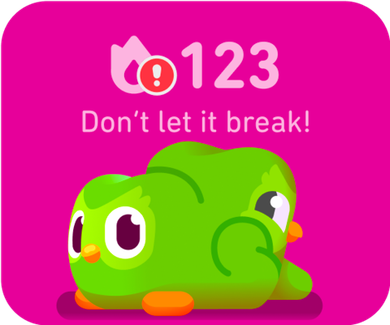
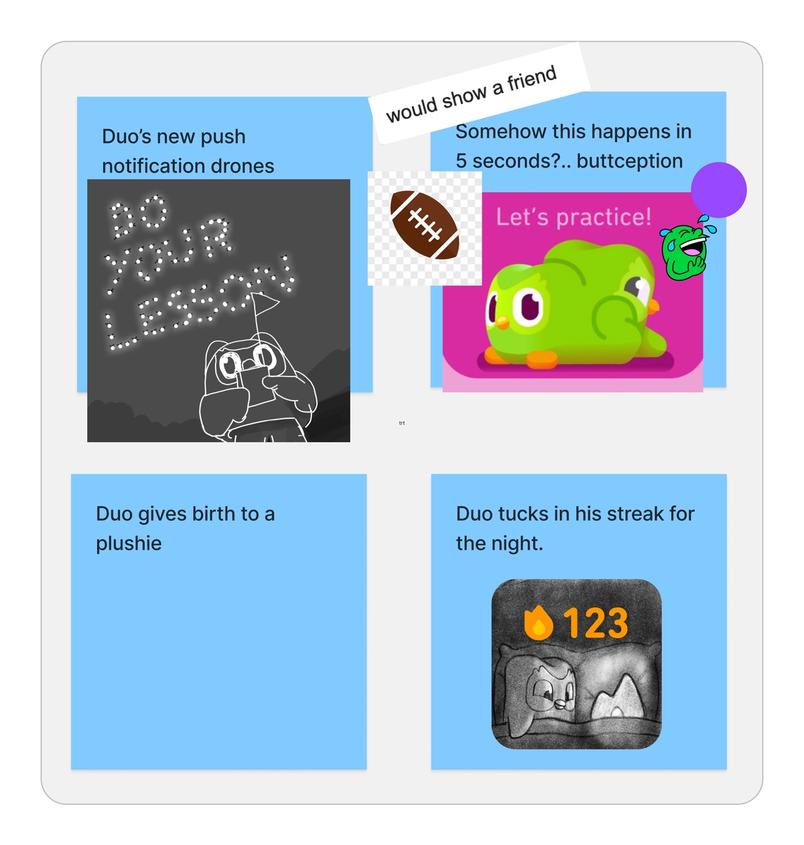
We realized that Duo is well known, and he’s the talent that we want to focus on.
Because the ad would air regionally in New York, Los Angeles, San Francisco, Miami, Detroit, and Pittsburgh, the push notification would also go out to Duolingo learners in those markets. But it wouldn’t be simple to orchestrate a send to four million learners in five seconds—the ask was, in fact, about 80 times above the company’s normal limit for notifications sent per second. “None of our tooling then was going to be up to the task, so we had to invent something new,” says Paul Rothenberg, Senior Technical Program Manager.
Finessing each frame
Duolingo’s in-house Design Studio was tasked with bringing the art to life. “Figma is universally the design tool of Duolingo from all the UX screen flows to illustrations, so it was the natural choice,” says Nick Forshee, Creative Director of Design Studio. Throughout the process, the team created the visuals with vector art in Figma, and the animations with Adobe After Effects.
Part of the challenge was making sure Duo stayed in the realm of funny and idiosyncratic, but not gross or alienating. “We did a ton of studies on the lighting, the shine, the shading, the actual butt growing,” says Nick. As for the moment it turned into a head: “We wanted to make sure it felt optimistic, and that the direction of the eyes guided you toward the type.”
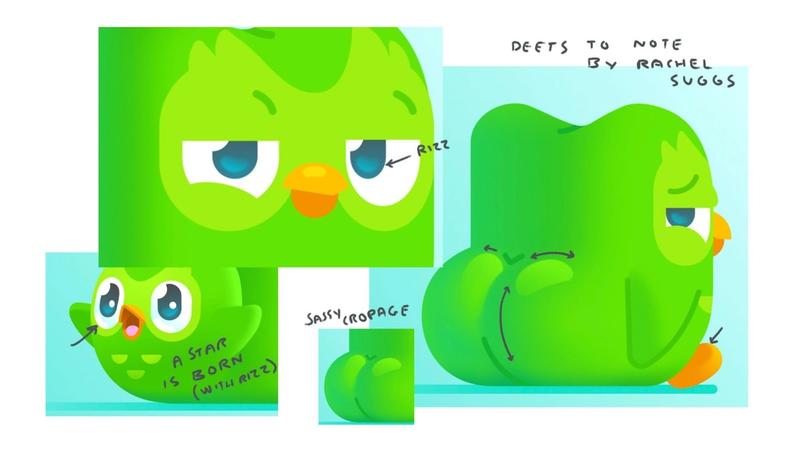
Four pivotal frames would comprise the five-second piece, and Nick estimates that each one took 6 to 10 iterations on composition, texture, and expression to reach the final version drawn by Illustrator Rachel Suggs. “Every decision had to be very intentional,” says Nick. “You could start with so many different cuts and compositions, and those are all subjective. We stuck with making sure each frame was something somebody could screengrab and turn into a meme.”
To ensure that the art would translate well to platforms like TikTok, where videos can be paired with popular audio clips, “We created an infinite loop of the artwork we have in our spot, and we timed the frames out to certain beats,” says James. “When we upload them onto social assets, they match with trending audio to gain more visibility.”
Cracking the copy
The team needed to get the message across in a short amount of time, so concision was key, but so were the shapes of the words themselves. “The proportions and spacing of certain words are quicker to read than others,” says Nick, “so ‘Do your language lesson’ was an immediate no.”

To telegraph the idea of language, the team toyed with versions like “Do your Spanish lesson,” but ultimately decided that narrowing it down to one dialect was too alienating. After two months of deliberation, the team settled on “Do your Duolingo.” Says Nick, “It’s become a common phrase—‘I did my Duolingo this morning’—and it works whether you’re doing math, music, German, Spanish.”
Cueing the audio
When it came to the sound effect, Nick had something up his sleeve—or rather, his armpit. “One of my talents is making fart sounds with my armpits, with great emotional range,” he says with a laugh. “So we did a recording session and recorded maybe 200 variations.”
In keeping with the creative direction, the version they chose sounded optimistic, one note growing out of another. “It had this offshoot note, and it really accentuated the way his face came out,” says Nick. “It was like music describing the picture.” The team then blended the sound with Duolingo’s correct-answer notification—a bouncy chime—to get the final sound.
Engineering a custom solution
The engineering team had a multi-pronged approach that addressed three challenges: sending a push notification at breakneck speed, making sure the site could withstand a spike in traffic, and ironing out the kinks in outdated legacy code to make the app more efficient. “For a five-second commercial, there needed to be exactly no engineering overhead at all,” says Paul, “meaning it couldn’t do anything except to send that note to those people at that time. There’s really not an off-the-shelf solution for that.”
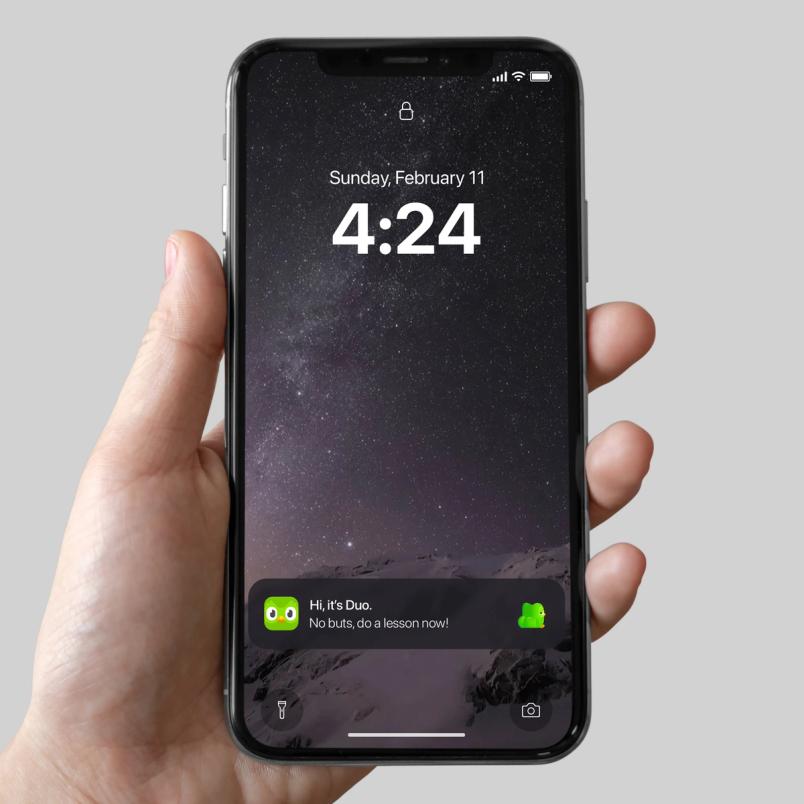
Talking to others in the industry who had worked on similar problems helped Paul and his team come up with some potential paths forward, but the nature of the Super Bowl presented a unique challenge. Because the event is live, they didn’t have the benefit of knowing exactly when the notification needed to be delivered. Other ideas would work if the time window were a matter of minutes—but they only had seconds.
“Since we had medium confidence, at best, that any particular option would have worked, we wanted to leave ample time for trial and error,” says Paul, “so the strategy was to get to testing as soon as possible.” The approach they tried involved was simple to implement, and had a high chance of becoming a prototype. The first test yielded decent send speeds overall, but showed “odd distributions in the length of time it was taking for the messages to be received.” Over several iterations, though, the results were faster and more predictable—and the team exceeded its send speed goals in the end: The push notification was sent to 95% of eligible learners within 3.9 seconds of the ad airing, and to 99% within 5.7 seconds.
Within minutes of the ad airing, people were celebrating its weirdness on social media, and industry creatives counted it as among the most inventive of the event. “Lovable and weird, the Duolingo Bird cements himself as a cultural icon both on and off social,” writes Chloe Bayhack, Senior Copywriter, and Caroline Mortensen, Senior Art Director of FCB in Adweek.
“Creativity thrives in constraints,” says James. “The constraint of the five-second spot, plus collaborating with minds from all different teams, adds to the diversification of ideas.” In this case, it didn’t hurt to have Duo’s fans cheering from the sidelines—after all, they’ve been the ones pushing the owl to unhinged heights. “Things that have gone viral are memes put out by our learners,” says James. “We just take those ideas and embrace them.”
Hero illustration by Peter Gamlen
Related articles



